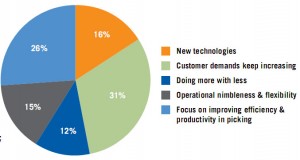American Barcode and RFID (AB&R) and Foxfire Software have teamed up to offer best-in-class warehouse management solutions. Continue reading the challenges for Today’s Warehouse Managers.
Introduction
In an effort to continue exploring how warehouse managers can become more effective, Foxfire conducted a survey asking its contact base of warehouse management professionals to identify major concerns and trends they currently see in the warehousing industry. Survey responses ranged widely, covering many different areas.
White paper author Don Benson, a third-party independent WMS specialist, analyzed and compiled the data, with the findings presented in this document. Benson, of WMS Support, has worked with warehouse managers for over 30 years.
Responses
A summary of the top 5 topics as reported by our survey takers:
- Customer demands keep increasing. In the down economy, there is no downturn on customer requirements. Customers are asking distribution centers (DCs) to change the way they operate to maintain their own businesses.
- Doing more with less. Our survey responders are being pressed to increase productivity, doing more in the DC with less cost, resources, etc. Budgets are being cut or remaining flat.
- Operational nimbleness and flexibility. DCs are being asked to change the operation quickly to accommodate fast-changing market conditions.
- Continued focus on improving efficiency and productivity in picking. Along with all the change, DCs are still being asked to improve efficiency and productivity in the most labor-intensive areas.
- New technologies. New technologies that enable all these things are important. Upgrading an old legacy WMS, implementing RFID, etc. are becoming options to consider.
In reading the responses, several interesting, related themes stood out:
- In these times of economic uncertainty, there is little money available and less motivation for purchasing and implementing new technologies;
- Respondents report a strong need to improve warehouse performance in many of the tasks and functions and to use the current building, equipment, systems and staff more effectively; and
- DC managers continue to look for new commercial offerings that help customers do more with less.
Anyone paying attention to the recent dynamics in our economy can immediately relate to why organizations are reluctant to invest in new technologies. There is also a need to improve warehouse performance with existing tools and technologies.
We found it particularly interesting that many of the specific concerns and tasks listed in the responses related directly to the core functions that warehouse management systems support:
- Increasing operational flexibility, handling volatile volumes;
- Organizing the daily workload to meet changing demands;
- Ensuring that FIFO, revision levels, or expiration dates guide inventory movement;
- Increasing storage capacity utilization;
- Tracking pallets;
- Improving bin management;
- Increasing accuracy of Cycle Counting;
- Implementing more efficient picking methods; and
- Increasing efficiency/effectiveness of existing resources.
I feel the survey results point to a critical issue with use of warehouse management systems, because effective use of a WMS is critical to achieving key organizational benefits. This includes the vitality and performance of a company, controlling costs, maintaining customer service, and building the capacity to compete in the global market and grow revenue.
This research suggests that many respondents who already have a WMS are not experiencing the full benefits of their system. Consequently, I began to think about what we might do now and how we may be able to improve in the future in serving our customers.
First, I looked at where we came from and what exists now.
Part 1: THEN (In the Beginning)
In the late 1970s and into the 1980s, when Foxfire started creating warehouse management systems, the WMS systems were implemented as a part of larger projects, creating or retrofitting a warehouse or DC. These projects relied upon the active participation of representatives from a wide range of stakeholders, from within the warehouse, within the company, and from the larger supply chain. These participants contributed to defining requirements and re-engineering processes, and this contributed to the design of the WMS. The WMS supports the DC in effectively serving the needs of the company and its supply chain and achieving company goals into the future. In this participation, the key people across the organization began to build the relationships that formed the foundation of successful collaboration and coordination across activities, departments, and companies.
My consulting firm shared responsibility for achieving business and operations goals, such as:
- Focus on the “management” of the warehouse as a whole, ensuring the performance of the separate function processes (receiving, picking, etc.) are integrated well together (line balancing) to optimize the performance of the total DC;
- Integrate the WMS technology well into the DC design and management, including requirements of company to reduce costs and support a market strategy to increase revenue, and so that the people working with the WMS understand the system and feel excited about learning to use it well to achieve those goals;
- Because the dynamic and changing demands on a warehouse are complex, we knew to achieve the company and project goals, it would require more than a WMS to optimize DC operations. Specifically we knew that success of the project and system would be directly a function of the skills of the people (managers, planner and staff) at implementing and working with the WMS. Because we knew that different people learn and develop skills differently, we initiated several approaches to build skills and sustain them in the DC, including
- Supporting the creation and development of user-documentation to communicate the explicit knowledge of the WMS and its operations and processes; and
- Building and supporting a learning community for WMS users to continue to build their capacity to optimize the performance of their DCs, bringing people together to learn from each other, to communicate the tacit knowledge of how the optimize warehouse performance in a wide range of ongoing, daily dynamics and requirements changes.
Part 2: TODAY – (What Exists Now)
Much has changed in the WMS industry since that beginning.
Vendors and technology:
- What were custom developed warehouse management systems are now available as products, made more robust with the continual addition of new functionalities, new operating systems and architectures, and associated technologies and applications;
- Warehouse management systems are sold and installed by a variety of vendors including OEMs, systems integrators, and a variety of partners and consultants, each with a different business model and process;
- The industry has provided little information for potential buyers to educate themselves about warehouse management systems and about how to approach developing requirements, selecting, configuring, and implementing them before making their purchase decisions.
Customers
- Selecting a WMS and vendor, and making decisions regarding implementation, have become less driven by measurable operations objectives and more by: a. Financial objectives focused on minimizing cost and time requirements; and b. IT considerations of lease vs. purchase, new architecture, and operating systems, etc.;
- The responsibility to achieve operations and business desired outcomes is now falling much more to the buyer;
- The purchasers of warehouse management systems typically have never engaged in a project of this complexity before and do not come to understand the impact and magnitude of change required to effectively implement it until deep into the work;
- Because the WMS is sold as a product, the people dimension of the change does not receive the attention required to obtain the maximum potential benefit, including:
- Skill building in the use of a WMS beyond initial training; and
- Relationship building to establish and maintain knowledge networks that strengthens the resilience of the warehouse and company in the dynamically competitive and risky world.
Part 3: THE FUTURE
So where does this take us? We know that the respondents to the initial survey are pointing in a direction that leads us to ask three new questions.
For those companies that now use a WMS –
- How do we go about proactively getting to optimal utilization of the functionality of our existing system; and
- How do we go about selecting and optimally utilizing additional new technologies/functionalities that will be connected to our WMS?
And, for those companies that are or will be considering the purchase of a WMS –
- How do we select, implement and optimally utilize a WMS recognizing that industry wisdom says that success depends on a combination of 50% people, 30% process, and 20% technology?
In Closing
Don Benson and Foxfire are committed to working with WMS users to solve these issues for current WMS users and prevent them from occurring with new WMS owners.
Wherever you fit in these three situations, we invite you to respond with your suggestions and descriptions of what has or has not worked. We commit to summarize the information we receive and publish it so we can collaborate in the continuing development of warehouse management systems.
ABOUT THE AUTHOR
Don Benson, P.E., has worked as a consultant, manager, and teacher for over 35 years, to improve the performance of warehousing and distribution operations. He participated in the very early development of Warehouse Management Systems and has supported management to achieve their goals to optimize the utilization of their resources to satisfy daily requirements and plan for the future.
ABOUT FOXFIRE
Foxfire solutions are instrumental for warehousing/distribution facilities and shop floor operations. Comprised of software, hardware, and professional services, the solutions deliver measurable returns. Foxfire’s Warehouse Management Systems (WMS) optimize inventory levels, increase order fulfillment rates, and reduce cycle times. Our Production Control systems support critical production activities, quality, and audit initiatives. In short, we provide solutions to help you run your businesses better.
